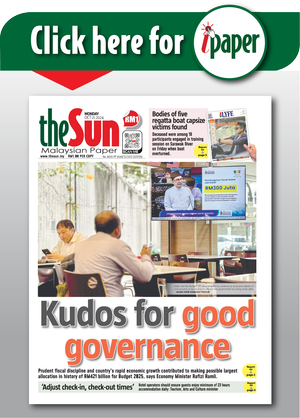KUALA LUMPUR: Malaysia’s broad money (M3) growth slowed to 2.5% year-on-year in February, down from 3.3% in January, marking its lowest level since September 2016.
Kenanga Investment Bank Bhd said this decline was primarily driven by a sharp slowdown in fixed deposits, which fell to 2.8% from 4.3% posted in January, the lowest in 33 months.
Currency in circulation also significantly dropped to 3% in February from 6.7% in January.
As a result, their combined contribution to M3 growth shrank to 1.4 percentage points (ppts) from 2.3 ppts in January.
The research firm said the M3 contracted by 0.4% month-on-month, reaching a six-month low, with a decline of RM9.2 billion in February compared to RM3.8 billion in January.
This marks the weakest performance since April 2021.
Declines in net government claims and slower private sector claims weighed on M3 growth.
Net claims on the government fell sharply to -2.4 % from 1% in January, the lowest since May 2018, as government deposits surged by 23% compared to 2.4% in January, far outpacing the expansion in government claims by 1.8% from 1.2% posted in January.
Meanwhile, claims on the private sector slowed slightly to 4.5% in February from 4.7% in January, driven by a moderation in loans to 5.4% from 5.7% in January.
Securities remained weak at -1.5 % for the second consecutive month.
Net foreign assets growth also slowed to 3.7% from 4.1% in January, a two-month low, due to a sharp deceleration in net foreign assets held by the banking system, which dropped to 12.8% from 25.1% in January.
However, Bank Negara Malaysia’s foreign assets rebounded to 1.3% in February from -0.9% in January.
Further, Kenanga said loan growth fell to 5.2% year-on-year in February compared to 5.6% in January, the lowest in 15 months and below the forecast range of 5.5–6%.
The research firm said the decline was mainly driven by slower loans for working capital, which dropped to 3.6% from 5.1% in January, and transport vehicles, which dropped to 7.4% from 8% in January.
Their combined contribution to overall loan growth shrank to 1.6 ppts compared to 1.9 ppts in January.
Residential property loans, which account for 37.8% of outstanding loans, moderated slightly to 6.7% from 6.8% in January, though its contribution to loan growth remained stable at 2.5 ppts.
By sector, loan growth slowed in manufacturing (3.2%) and motor vehicles (4.8%), while persistent weaknesses were observed in agriculture (-8.1%), mining and quarrying (-8.6%), construction (-7.5%), and education, health, and others (-5%).
The household sector, which holds the largest share of loans at 59.9%, remained stable at 6%, contributing 3.6 ppts to overall growth.
On a month-on-month basis, loan growth moderated to a 10-month low of 0.1%, adding RM2.5 billion to total outstanding loans, partly due to fewer working days in February.
Deposit growth expanded to 3.5% year-on-year in February compared to 3.1% in January, reaching a three-month high, driven by a rise in foreign currency deposits (14%) and a second consecutive month of growth in repurchase agreements (6.8%).
On a month-on-month basis, deposits grew by 0.9% (Jan: 0%), adding RM23 billion, the highest increase in eight months.
“Loan growth may face pressure in the near term due to last year’s high base effect, but we expect it to pick up towards year-end, driven by steady domestic economic expansion.
“We expect BNM to hold the overnight policy rate at 3% for the remainder of 2025.
“While external uncertainties may dampen the GDP growth trajectory, we expect the adverse impact to be limited, supported by domestic demand. Meanwhile, inflation is projected to rise to 2.7% in 2025 due to domestic policy changes,“ Kenanga said.









